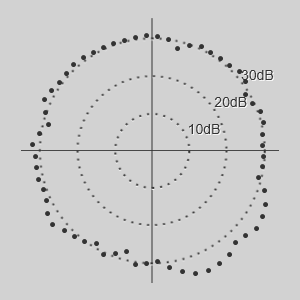Making a noise/speed curve to determine vessel noise
The performance of the ST90 system will always be limited by different noise sources. During this test, noise measurements are done for different vessel speeds. The weather and sea conditions for the noise measurements will be those at the time of the test.
The ST90 system is turned on and operates normally. The vessel is at sea. Recommended minimum depth is 100 metres. If the ST90 system is operated from any other compartment than the bridge, an open two-way oral communication channel with the bridge is required. You need the following equipment:
- Personal computer
- Spreadsheet program
If you wish to do the test with a "silent ship" the following prerequisites must be met:
- The water must be as deep as possible. Recommended minimum depth is 100 metres.
- There must be no other vessels in the vicinity.
- As much machinery as possible must be turned off. It is particularly important to turn off electrical motors, as well as cooling systems and hydraulic pumps that may cause electric noise.
- To prevent interference, all other hydroacoustic instruments must be turned off.
If you do this tests in a busy harbour, or with noise sources present, the sensitive receivers will detect all the noise in the nearby waters.
To measure the noise, observe the noise values provided on the Noise page in the Diagnostics dialog box. Since the noise will vary with each ping, you must make five measurements for each vessel speed, and then calculate the average noise.
If you record all the raw data during the noise test, you can repeat the test later using the replay file.
You may wish to make the noise/speed curve under realistic conditions. This means that all relevant vessels systems are in normal use. If you experience very high noise levels, you may wish to repeat the test with "silent ship" settings. To isolate noise sources, turn individual vessel systems off, and check for any changes in the noise level.
When the transducer is fully lowered, the speed of the vessel must not exceed the maximum speed permitted for the hull unit. This maximum speed depends on the physical size of the transducer, the mechanical construction of the hull unit, and how far down the transducer has been lowered. The System Protection page allows you to define a limit that triggers an alarm if the maximum speed is exceeded. The System Protection page is located in the Installation dialog box.

Illustration:
Read the noise value from the noise circle. Use the mean value of the readouts at 0 degrees (straight up).
Procedure
- Make sure that you have sufficient water depth below the keel before you lower the transducer.
- Lower the transducer to its bottom position.
- If necessary, establish a separate communication line with the bridge to verify the vessel speed during the test.
- Make the following
preparations.
- At the bottom of the display presentation, select Bow Up presentation mode, and activate the Horizontal view.
- Open the Operation menu.
Set Operation to Normal.
Set Tx Power to Off.
- Open the Active menu.
Set TVG (Time Variable Gain) to 0 log R.
Set Ping-Ping Filter to Off.
Set Pulse Type to CW Short.
Set Frequency to the start frequency:
Set Horizontal TX Sector to Omni.
Set Vertical TX Sector to Normal.
Set AGC (Automatic Gain Control) to Off.
Set RCG (Reverberation Controlled Gain) to 0 (zero).
Set Noise Filter to Off.
- Open the Setup menu.
- Select Diagnostics to open the dialog box.
- Select Noise to open the page.
- Select Start Noise Measurements.
- Repeat for each vessel
speed and operating frequency.
- Ask the bridge to set the speed.
- If possible, verify the vessel speed on the top bar.
- Read the noise value from the noise circle.
- Record the values in the result table.
- Repeat for every 2
kHz up to and including the highest test frequency: 24 kHz
Increase the operating frequency with 2 KHz.
Read the noise value from the noise circle.
Record the values in the result table.
- Ask the bridge to set the next speed.
- When all the measurements have been made, type the data (speed and noise) into a spreadsheet to create the curve.
- Finish the test.
- Close the Diagnostics dialog box.
- Hoist the transducer back up to its upper position.
| Speed/Frequency/Noise | ||
|---|---|---|
| Speed | Frequency | Noise level |
| 0 | ||
| 2 | ||
| 4 | ||
| 6 | ||
| 8 | ||
| 10 | ||
| 12 | ||
| 14 | ||
| 16 | ||
| 18 | ||
| 20 | ||
| Sea state: | ||
| Water depth: | ||
| Use this table to record the values. Print it out and make multiple copies. Alternatively, you can type the values straight into a spreadsheet. | ||
